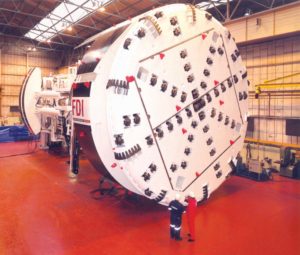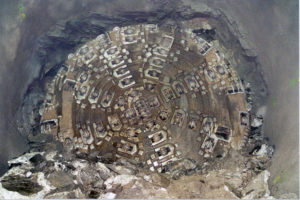![65 Years of Innovation and Experience [default]](https://www.robbinstbm.com/wp-content/uploads/2017/04/Side-Bar-Blue-Blocks_70-Years.jpg)
UNA SOLUCIÓN PARA CADA SITUACIÓN: EXPLORE NUESTRA BASE DE DATOS DE PROYECTOS
Mapa de proyectos
FEATURED PRODUCT: CROSSOVER MACHINES
NUESTRA HISTORIA
Un legado de innovación
INFORMACIÓN ACTUALIZADA
Noticias y medios
NUEVAS PERSPECTIVAS EN EL SECTOR
Lea el blog de Robbins
 The Manapouri Hydropower Station is the largest hydropower station in the country and supplies 5100 GWh of electricity annually. In 1997, the project owners, Electricity Corporation of New Zealand (ECNZ), proposed an expansion of the hydropower station from its then output of 585 MW. The plan included a second 9.6 km (6.0 mi) long tailrace tunnel connecting the underground power station at Lake Manapouri to its discharge point in Doubtful Sound.
The Manapouri Hydropower Station is the largest hydropower station in the country and supplies 5100 GWh of electricity annually. In 1997, the project owners, Electricity Corporation of New Zealand (ECNZ), proposed an expansion of the hydropower station from its then output of 585 MW. The plan included a second 9.6 km (6.0 mi) long tailrace tunnel connecting the underground power station at Lake Manapouri to its discharge point in Doubtful Sound.
In 1997 ECNZ awarded the construction contract, worth US $85 million, to a Joint Venture of Fletcher Construction (New Zealand), Dillingham Construction (U.S.), and Ilbau (Austria). The joint venture awarded the contract to Robbins for one 10.05 m (33.0 ft) diameter Main Beam TBM to excavate the tunnel.
The tunnel passed through Paleozoic metamorphic and igneous rocks. The metamorphic rocks included gneiss, calcsilicate, quartzite, and intrusions of gabbro and diorite. The tunnel geology also included five sub-vertical fault zones with high potential for water inflows.
Robbins designed the 10.05 m (33.0 ft) diameter TBM for the mixed face hard rock conditions in the tunnel. The Robbins design was then built by Kvaerner-Markham (U.K.) and shipped to the job site. The cutterhead featured sixty-eight 17 inch (432 mm) cutters with loading from either the front or back. Eleven two-speed electric motors powered the cutterhead with 3,463 kW (4,642 hp), generating a torque of 9,859,400 N-m (7,271,919 lb-ft). The 470 m (1,542 ft) long back-up system, built by Rowa Engineering, included a secondary rock-bolting station and a robotic shotcrete station.
 The Robbins TBM began boring in June 1998 and finished in 33 months. The tunnel progress was divided into four sections, or reaches. During Reach 1, about 1.8 km (1.1 mi) into the bore, the machine experienced few problems. During Reach 2 (spanning 2.4 km (1.5 mi)), the machine encountered heavy water inflows through the fault lines. These inflows reached proportions of 1,300 liters (343 gallons) per second and pressures up to 7.2 MPa (1.0 ksi). These high volumes of inflow necessarily slowed progress throughout Reach 2. Geological conditions improved in Reach 3 (spanning 2 km (1.2 mi)), and by Reach 4 (spanning the final 3.2 km (2.0 mi)) the machine was progressing at a substantial rate.
The Robbins TBM began boring in June 1998 and finished in 33 months. The tunnel progress was divided into four sections, or reaches. During Reach 1, about 1.8 km (1.1 mi) into the bore, the machine experienced few problems. During Reach 2 (spanning 2.4 km (1.5 mi)), the machine encountered heavy water inflows through the fault lines. These inflows reached proportions of 1,300 liters (343 gallons) per second and pressures up to 7.2 MPa (1.0 ksi). These high volumes of inflow necessarily slowed progress throughout Reach 2. Geological conditions improved in Reach 3 (spanning 2 km (1.2 mi)), and by Reach 4 (spanning the final 3.2 km (2.0 mi)) the machine was progressing at a substantial rate.
Despite setbacks due to water, the Robbins TBM suffered no major breakdowns and availability remained high throughout the dig. In addition, total TBM spare parts usage was far below the industry average for this type of job.

 Close
Close